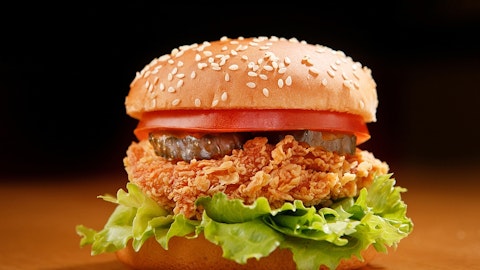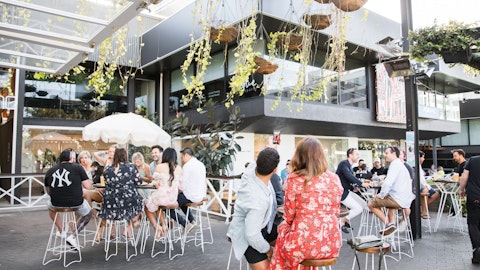Vance Chang: So the G&A level we have right now is what we believe that the right level to run the company going forward with the growth plan that we have in mind. As we talked about before, the technology initiatives, we’ve concluded with that, so that’s impacting G&A and CapEx both, right? But with the G&A we’re redeploying those — the G&A resources towards development now. So we’re keeping G&A at a fairly constant level but we’re investing in the development capabilities, and that includes a lot of the functionalities that we — that John talked about before, which is to source deals in a different way, to support the franchisees in a different way that we — on a more centralized fashion. And so that’s what we plan on doing going forward.
One other reminder is just that for this quarter, if we do not count the non-cash items, which is stock based comp and depreciation and amortization within our G&A, the cash portion of the G&A is actually $2 million to $3 million lower versus the year before. So we have been and we will always be very disciplined with G&A bank management. And your second part of the question in regards to buybacks, we know — we believe that there is growth potential with the stock and with the company and their opportunities create shareholder value for us in the long term. So we have been and we will always be in the market when we see that there is a disconnect with the intrinsic value of the company and where the shares are trading at. So that will be — will always be an important part of how we return capital to shareholders.
Operator: Our next question comes from the line of Brian Vaccaro of Raymond James.
Brian Vaccaro: Just a few follow ups, if I could. I believe you said that Applebee’s traffic outperformed in the first quarter. Just to make sure we’re on the same page. Could you level set where average check was for each brand in the first quarter?
John Peyton: I don’t have that data in front of me, Vance. Can you address that question?
Vance Chang: So Brian — so average check for Applebee’s is slightly positive, offsetting the negative traffic, but the traffic we did with Black Box for the quarter. For IHOP, average check was probably in more of the high single digit range, given the menu pricing increase, the effect of menu pricing increase in Q1. So that’s the context.
Brian Vaccaro: So check slightly positive at Applebee’s and IHOP in the high single digits. I might have misheard it, but I think your comments on franchisee profitability, were those as of the fourth quarter? I guess, that’s the most recent quarter you have visibility on? Do you have financials on? So with sales mix on value promotions jumping now into the high 20s, can you speak to the impact that’s having on franchisee profitability? It sounds like you’ve got a good guy on the commodity side insulating. But to what degree has that jump in promotion impacted profitability, and is this level sustainable in your view?
John Peyton: I’ll start with that and Vance fill in if I miss anything you think is important. The most important thing about our approach, meaning all three brands approach to promotions, Brian, is that they are profitable promotions as they’re designed. And that is the case and it’s ensured by the fact that we construct promotions with input from our franchisees and they’re on board with doing them. A good example is even DOLLARITA, right? For a Margarita for a dollar is profitable in itself. And the last time we ran it in the fall, 90% plus of those DOLLARITA tickets included other items, which is exactly what it’s designed to do. So we believe that as long as the promotions are constructed to drive profit as a standalone, to be profitable standalone and then drive additional business, that is the strategy that we’re following in conjunction with our franchisees. Vance, is there any color you can add that would be helpful?
Vance Chang: So as John mentioned, it’s all about driving incremental profitable traffic. So another detail I would add on the DOLLARITA is that — so it’s more than just the DOLLARITA itself. There are different shots, flavors, different additions we can — we’re offering that adds to the margin of that drink and then — in addition to the food attachment rate of that of that order. So the point of it is to drive the lifetime value of that guest and increase sort of the long term market share of the brand. So we’re not giving things away. These are prudent, methodical, creative campaigns that we’re running.
Brian Vaccaro: And then just the last one for me. In the first quarter, just looking at the financials, it looked like advertising accrual at Applebee’s was down 4% or so. And is that representative of the actual spend or TRPs in the market in the first quarter? I know sometimes there can be differences versus what’s in the financials versus actual spend. But if that was the case, did that have a negative impact on your comps? And just thinking more broadly in the more competitive value environment, what’s a reasonable expectation on advertising at Applebee’s for the rest of the year? Might that be down as well or just any color there would be great?
Vance Chang: So on a very high level basis, think of advertising spend as roughly a — it should trend similarly as comps. So if sales are up, advertising spend will be up. If sales are down, advertising spend will be slightly down. But what you’re referring to also is driven by timing. So the dollar spend isn’t exactly tying to — it just depends on payment timing, depends on the campaigns we’re running, depends on things we’ll work out with our agency. So there’s going to be some of that noise in there. But for the most part, it should be fairly consistent with sales trends.
John Peyton: And then Vance, I think it would be helpful if Tony addressed the advertising strategy overall for Brian.
Tony Moralejo: I can’t get into specific plans, obviously, due to competitive reasons, but we feel really confident where our calendar sits for the remainder of the year. We’re not going to be spending less money. We are spreading it out over more calendars and windows and we’re changing our mix a little bit between traditional media and digital. But the strategy remains the same and the volume, the breadth and depth of the marketing plan remains the same. So we’re going to provide our guests with value, especially during these inflationary times. And we’ll lean hard on our award winning advertising and our robust fund to support the entire portfolio of propositions that you’ll see for 2024.
Operator: Our next question comes from the line of Jeffrey Bernstein of Barclays.
Unidentified Analyst: This is [Pratik] on for Jeff. I just had a quick modeling question and then a real question. I apologize if it’s already out there. But are we going to get four quarters worth of historical results for Fuzzy’s, now that the brand is fully integrated or will we just kind of continue to get quarterly updates with the current quarter and the prior year quarter?
Vance Chang: I can answer that. So the reason why we didn’t provide comps the year before is because last year was the first year we’ve owned the company. And so going forward, we’ll provide quarterly comp performance versus last year. But we wouldn’t provide last year’s comp, because we didn’t own the company the year before that, if that makes sense.
Unidentified Analyst: And then my real question was really following up on Dennis’ question. Your brand has obviously always been positioned for value and there’s been a lot of talk from your peers the past few days about consumers feeling pressured. Can you just talk about if you’ve seen a meaningful change in the types of guests that you’re seeing in your brand, like maybe some at the low end have been trading out, but maybe some other guests have been trading into your brand? Just any color on what you’re seeing right now would be really helpful.
John Peyton: I don’t know that we have that much more to add to what we’ve already said. In that we are –what I can clarify though is that we are seeing more change in terms of our lower income guests having less visits with us than we are in seeing growth in the upper tiers of our income band. Meaning we’re not seeing as much trade down into the brands. We’re seeing some. But the most impactful change in consumer behavior is clearly at the $50,000 and below segment.
Operator: I am showing no further questions at this time. I would now like to turn it back to John Peyton, Dine Brands’ CEO, for closing remarks.
John Peyton: Julia, thank you for your expert moderation. We appreciate it. Thanks to Jay, Tony and Vance, and thank you guys for joining us this morning and asking us your questions. We’ll talk to you throughout the quarter, and look forward to next August call. Have a great day everybody.
Operator: Thank you for your participation in today’s conference. This does conclude the program. You may now disconnect.
Follow American Fabricators Inc (NYSE:DIN)
Follow American Fabricators Inc (NYSE:DIN)
Receive real-time insider trading and news alerts



